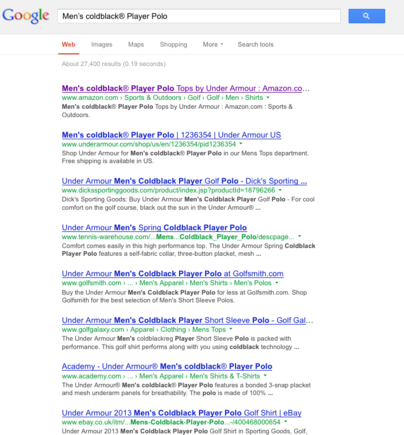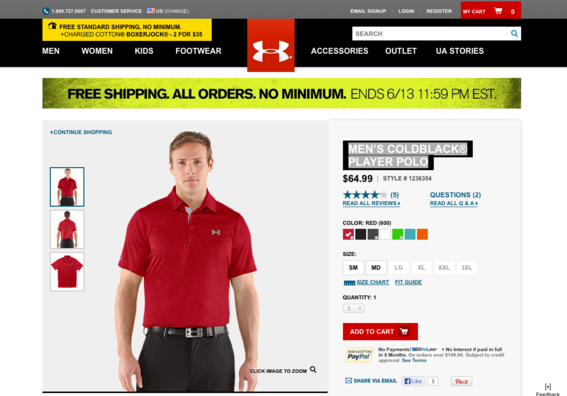If you sell branded consumer products in your online store, your business is at a high risk because of the multi-channel strategies of manufacturers, marketplaces, and large specialty retailers.
Let’s say you sell Under Armour products. One of your items is a “Men’s Coldblack® Player Polo” that lists for $64.99. In addition to competition from Amazon.com, DicksSportingGoods.com, Golfsmith.com, and other specialty retailers, you now compete directly with UnderAmour.com. In fact, Under Armour is targeting 25 percent of its revenue to be generated from its online store. Under Armour is currently number 143 on the Internet Retailer Top 500 Guide and derives 9 percent of its revenue online. So you can see it has an aggressive online strategy to go from 9 to 25 percent.
Here’s what a consumer would find on Google by searching for this shirt.
Google search results for "Men’s Coldblack® Player Polo." Enlarge This Image
Enlarge This Image
As a consumer, I am likely to choose one of the top sites for this item. In fact, since UnderArmour.com is the second choice, I am likely to go there first, as it may have the largest selection of colors and sizes. Here is a screenshot of UnderArmour.com’s “Men’s Coldblack® Player Polo” landing page.
"Men’s Coldblack® Player Polo" product detail page, at UnderArmour.com.
UnderArmour.com is a well-designed site, offering free shipping on all orders. If I like Under Armour products and am not trying to buy non-related items, I may also shop for other accessories or similar items while I am there. There would be no reason to shop at other stores.
If I decide to shop elsewhere, I will find the same basic selections and price at Amazon.com and DickSportingGoods.com and other smaller retailers. In most cases, they offered free shipping with a $49 order. So I could buy this shirt on many sites for the same price, before sales tax.
Since the pricing is consistent, Under Armour appears to protect its pricing as much as Apple and other major brands. If you are a smaller retailer, how do you successfully sell Under Armour and compete against these types of companies?
You may be thinking that its best to sell other branded products that are not structured this way. For now, that may be a workable strategy. But virtually all brands are moving toward this type of multi-channel model. They are investing heavily on online operations — sophisticated online stores, social media investment, and digital marketing. They likely have mobile-optimized stores and many also support apps. If you buy from them, they will market aggressively through email. They will likely offer promotions, free shipping, and possibly even loyalty rewards.
Build Customer Loyalty
In short, smaller online retailers must develop customer loyalty and improve their retention to succeed against these larger competitors. Price discounts will hurt your margins, and with branded items it may be more difficult to discount in the future. You need to find other items to sell, to retain customers.
It is far less expensive to resell to an existing customer than it is to acquire a new one. Let’s look at some of the ways to improve customer retention.
Improving Customer Retention
Amazon.com is using its Prime program to great advantage as a loyalty device. In addition to free two-day shipping on any order, members also receive benefits through Prime Instant Video and Kindle Owner’s Lending Library. Amazon also knows that Prime members spend much more time shopping on its site, thus increasing Amazon’s opportunity for more sales.
Smaller merchants need to develop their own loyalty programs that are similar to Prime. A good place to start is some level of free shipping. Since most online stores offer free shipping at some level, why not package it for all orders? It does not have to be 2-day shipping. It could be a single yearly charge like Amazon, or a one-time offer to purchase at a particular level and then receive free shipping for a year.
Structuring a Loyalty Program
But don’t use free shipping by itself as your loyalty program. By adding other benefits, you will increase your repeat business and customer retention rate. The lifetime value of a customer will increase with a well-designed and managed loyalty program. Some other elements of a program you may consider are:
- Same day or priority shipping;
- Free returns including return shipping;
- Exclusive offers for members only;
- A 5 to 15 percent discount on all orders based on the size of an individual order;
- A 5 to 15 percent discount on all orders once a milestone purchase level is achieved in a given time period;
- Reward points that can be accumulated for future purchases or discounts;
- Early access to new items or promotions;
- Secure access to personalized pricing based on your purchase levels;
- Occasional giveaways;
- Price matching offers.
In some cases, you may want to create a simple program that includes just free shipping and returns. Perhaps reward points make the most sense for your type of business. You may even want to have multiple levels. Evaluate your competitors to gauge the most effective elements of your loyalty program. Survey your customers to determine what would motivate them to buy more.
The point is to develop a program of some sort. Market it everywhere: on your home page, on product pages, in your shopping cart, in your emails, on social media. Tie it into your brand so that people associate your brand with that program. That way, if a consumer shops for a branded product like Under Armour, he may not get a direct discount from you on the purchase, but perhaps he’ll earn points for a future purchase, receive free shipping, and know that he doesn’t have to pay for the return shipping if the product is not as expected. That might be reason enough for him to go to your store for the purchase rather than a larger retailer where he has no prior relationship.


